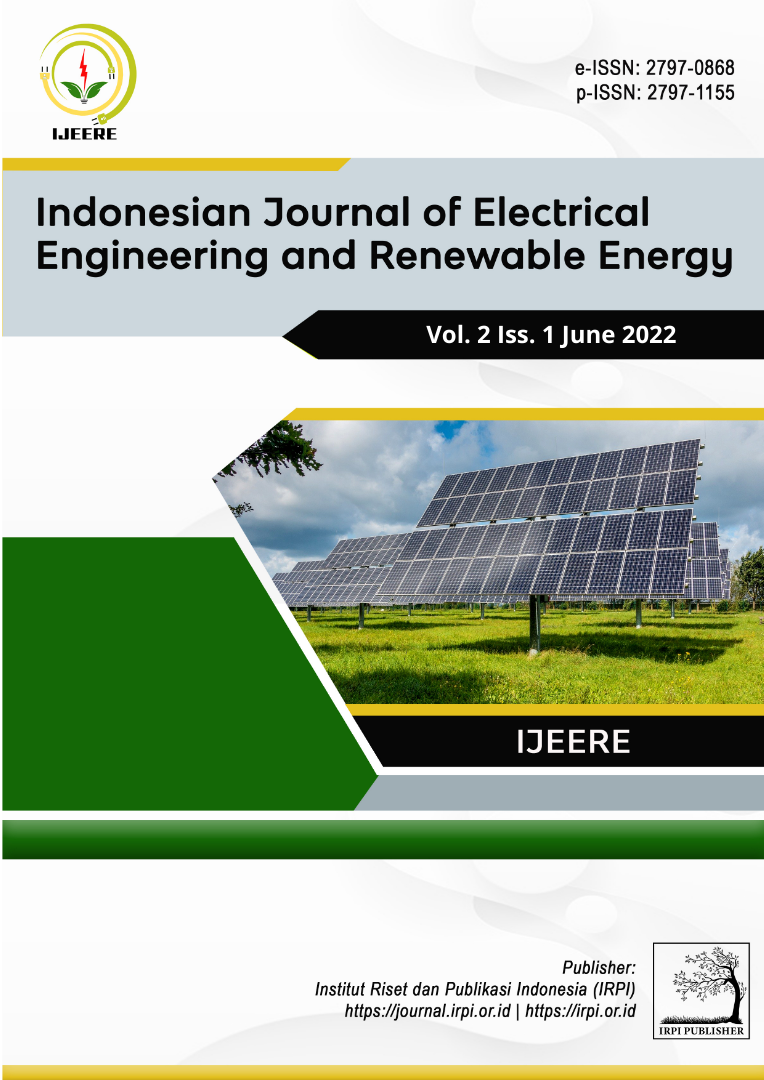Technical Analysis of Bioethanol Production and Electrical Power Potential By Utilizing Cassava Wastea
Analisis Teknis Produksi Bioetanol dan Potensi Daya Listrik Dengan Memanfaatkan Limbah Singkong
DOI:
https://doi.org/10.57152/ijeere.v2i1.93Keywords:
Bioethanol, Generator Set, Cassava Waste, Power Potency, SuperProAbstract
Cassava production in Riau Province has bioethanol potential which is quite capable as a substitute for fossil fuels. Bioethanol is an alternative and environmentally friendly energy that can be used as a fuel mixture for generator sets. One of the highest sources of raw material for bioethanol production is the cassava plant. Waste originating from cassava dregs and peels is still not fully utilized, even though this waste contains carbohydrates which can be converted into ethanol. Based on the content derived from cassava itself, it has a starch content of 35% which contains amylose and amylopectin which can be converted into ethanol. The method used in this research is descriptive research with biochemical conversion. This study aims to determine the electrical potential generated by bioethanol from cassava waste so that it is expected to reduce the use of fossil fuels. To determine the level of ethanol produced, it can be done by simulating it in the SuperPro software. The steps taken to produce bioethanol are pre-treatment, hydrolysis, fermentation, and purification, from the total production of cassava as much as 203,417 tons / year, 25,683 kg / hour of cassava will be used with 1093.4 L / day of bioethanol. The 100% power potential without a gasoline mixture is 266.75 kW, while 10% ethanol with a mixture of 90% gasoline is 402.79 kW.
References
BPPT, “Indonesia Darurat Energi,” 2018. https://www.bppt.go.id/teknologi-informasi-energi-dan-material/3296-bppt-indonesia-darurat-energi (accessed Jan. 11, 2021).
Dinas Ketahanan Pangan Riau, Buku Statistik Pangan Tahun 2019. DISKEPANG.RIAU.GO.ID, 2019.
Badan Penelitian dan Pengembangan Pertanian, “Agro inovasI 2 AgroinovasI,” Agroinovasi, vol. edisi 4-10, no. 29, 2011, [Online]. Available: www.litbang.deptan.go.id.
R. Prihandana et al., Bioetanol Ubi Kayu; Bahan Bakar Masa Depan. Jakarta: AgroMedia Pustaka, 2007.
S. Fano, “Pra Rencana Pabrik Etanol dari Ubi Kayu dengan Proses Fermentasi Kapasitas 20000 Ton/Tahun,” Universitas Tribhuwana Tunggadewi, 2008.
S. Susilo, “Rancangan dan Uji Kinerja Alat Distilasi Etanol Dengan Metode Rektifikasi,” Institut Pertanian Bogor, 2009.
Oktovero, “Pemodelan Proses dan Analisis Ekonomi Produksi Bioetanol Dengan Memanfaatkan Sampah Makanan di Kota Pekanbaru Sebagai Bahan Bakar Generator Set,” UIN Sultan Syarif Kasim Riau, 2017.
D. of E. U.S., “Clean Cities Alternative Fuel Price Report,” 2016. http://www.afdc.energy.gov/uploads/publication/alternative_fuel_price_report_july_2016 (accessed Jan. 24, 2021).
I. Said and P. H. Abram, “Erna, Said, I., & Abram, P. H. 2016,” vol. 5, no. August, pp. 121–126, 2016.
D. S. Laboratorium, U. S. Ratulangi, and U. S. Ratulangi, PRODUKSI BIOETANOL DARI SINGKONG (Manihot utilissima) DENGAN SKALA LABORATORIUM, vol. 2, no. 1. 2013.
Y. M. D. PUTRA, “PEMODELAN PROSES DAN ANALISA TEKNIS PRODUKSI BIOETANOL DENGAN MEMANFAATKAN LIMBAH TAHU,” Riau, 2018.
Downloads
Published
How to Cite
Issue
Section
License
Copyright (c) 2022 IJEERE: Indonesian Journal of Electrical Engineering and Renewable Energy

This work is licensed under a Creative Commons Attribution-ShareAlike 4.0 International License.




















